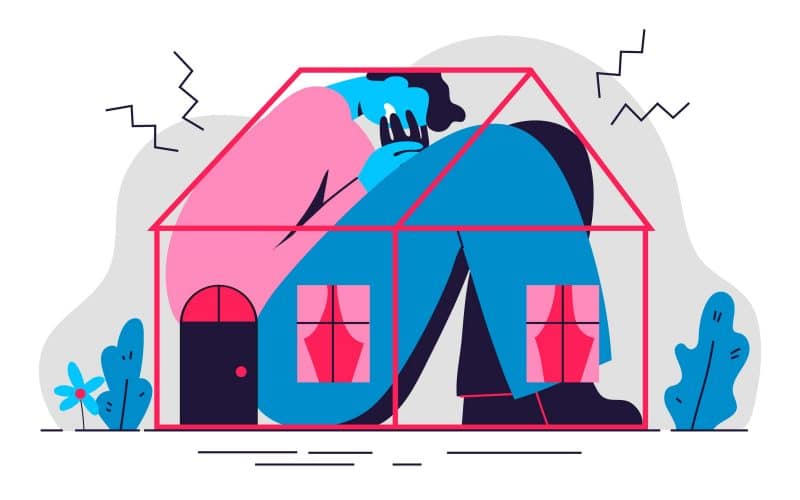In general, home hazard insurance is often considered synonymous with catastrophe insurance. However, while both deal with coverage for large-scale, natural disasters, they are technically different.
Hazard insurance, within the insurance industry, refers to a portion of a general homeowners insurance policy that protects the structure of the home. Catastrophe insurance, on the other hand, usually refers to a separate, freestanding policy that covers specific types of disaster, including man-made ones.
Home hazard insurance protects a property owner against damage caused by fires, severe storms, hail/sleet, or other natural events. As long as the specific weather event is covered within the policy, the property owner will receive compensation to cover the cost of any damage incurred.
Typically, the property owner will be required to pay for their premiums with an escrow account, but this practice will depend on the exact details of the policy.
How home hazard insurance works
Home hazard insurance generally refers to the coverage of the structure, roof, and foundation of your home only. However, in some policies, it can be extended to furnishings and personal belongings, as well. It protects a property owner against damage caused by fires; lightning; hail-, wind-, snow-, or rainstorms; or other natural events.
Hazard coverage is usually a subsection of a homeowners insurance policy that protects the main dwelling and other nearby structures, such as a garage. To be prepared for every contingency, homeowners should be sure that specific, common hazards are covered in their insurance policy package.
The amount of hazard insurance required depends on what it would cost to replace the home in the event of a total loss. This dollar amount may differ significantly from the property’s value in the current real estate market. Policies are typically written for one year and are renewable.
Hazard insurance and Mortgages
If you have or are taking out a mortgage on your home, it’s common for your lender to require you to carry homeowners insurance. Strictly speaking, what they want you to have is, in fact, hazard coverage since it is the portion of the homeowners’ insurance directly related to the home structure itself (as opposed to personal liability, loss of use, or personal property coverage).
Usually, purchasing a general homeowners policy will satisfy the lender’s requirement, though the level of protection required will depend on the laws of the local municipality and other special considerations. If you have a very expensive property in a high-risk area, the lender may require additional coverage.
Separate hazard insurance policies
In some areas, certain natural or weather-related activity is excluded from the hazard coverage of homeowners insurance—usually because the area is so prone to these events, and it’s too costly for the insurance issuer to include them in a standard policy.
For example, a Florida beachfront property can be susceptible to hurricanes and tropical storms; California properties located close to fault lines face earthquake threats.
If homeowners live in a high-risk area, they often need a separate hazard insurance policy to adequately protect their property. This can be a flood insurance policy, or a policy that protects property against landslides (such movements of the earth are rarely covered by conventional homeowners insurance’s hazard coverage).
What does home hazard insurance cover?
Here are the hazards (perils) commonly covered by hazard insurance:
- Fire and lightning
- Smoke
- Volcanic eruption
- Theft
- Windstorm and hail
- Explosion
- Weight of ice and snow
- Riots
- Vehicles
- Aircraft
- Vandalism
- Falling objects
- Freezing of household appliances or heating, plumbing, air conditioning systems or sprinkler systems that put out fires
- Accidental overflow of water from household appliances or heating, plumbing, air conditioning systems or sprinkler systems that put out fires
- Accidental damage due to short-circuiting of an electrical current
- Accidental cracking, burning, or tearing of heating, plumbing, air conditioning systems or sprinkler systems that put out fires
If one of these problems damages your property, the hazard or dwelling portion of your policy will cover repair costs. In general, hazard insurance will cover only the perils that are listed in the policy. But a standard homeowners policy, called an HO-3, will cover all problems that damage your house except ones that are specifically excluded.
Hazard insurance requirements can differ by lender and by location. For instance, while wind damage is usually covered by homeowners insurance, in some coastal areas it may be excluded from a home insurance policy. If your hazard insurance excludes windstorm damage or your lender requires it, you will have to buy a separate windstorm policy.
What does home hazard insurance not cover?
There are certain things that home hazard insurance won’t cover, such as:
- Injuries that occur on your property
- Damage to or theft of your personal property
- Damage from a flood or earthquake
- Mold damage
Personal property and liability are included, though, in a standard home insurance policy. Mold damage can be covered if it’s caused by a peril covered by the policy.
Floods and earthquakes are not covered by homeowners insurance. You can buy flood insurance from the National Flood Insurance Program or a private insurer. You can pay to add earthquake insurance as well.
Cost of hazard insurance
Home hazard insurance is just one part of a homeowners insurance policy, and typically the cost isn’t broken out by coverage type. Forbes Advisor found a national average home insurance rate of $1,854 a year. That’s for a policy with $300,000 in dwelling coverage.
With hazard insurance, you need to pay a deductible if you file a claim, which is the amount of money deducted from an insurance claims check. You’ll be able to find your deductible amount on the policy declarations page of your home insurance policy.
Your insurance costs will depend on the amount of coverage and deductible you choose, your claims history and the size and materials of your house. Other factors typically impacting the cost of home insurance are where you live and your credit.
How much hazard insurance do you need?
Hazard insurance covers your home up to a certain dollar amount or limit. You’ll generally want a high enough limit to cover the full cost of rebuilding your home if it’s destroyed.
Keep in mind that this figure, known as the “replacement cost” of your home, isn’t necessarily the same as the property’s purchase price. Instead, it’s based on the estimated cost of materials and labor needed to rebuild the house to its pre-disaster condition. Your insurer can help you estimate the right amount.
For a little extra peace of mind, consider one of these optional types of coverage:
- Extended replacement cost. When a hurricane or wildfire causes widespread damage in a certain region, local construction costs often go up due to higher demand. If this happens, your replacement cost coverage might not be enough. Extended replacement cost coverage offers a buffer against such shortfalls. You may be able to choose an amount anywhere from 10% to 50% above your coverage limit in case costs are higher than expected.
- Guaranteed replacement cost. Going a step further, guaranteed replacement cost coverage pays as much as necessary above the dwelling coverage limit to rebuild your home.
How to get a home hazard insurance policy
Most major insurers sell homeowners policies, which include hazard insurance. You can look for home insurance quotes online or ask an independent insurance agent to shop around on your behalf.
To get the best price, it’s smart to compare quotes from at least three insurers.
How to save money on hazard insurance
The most effective way to save on your home insurance is to shop around and compare quotes for the same types and levels of coverage. One way is to ensure that you are earning all the discounts for which you are eligible. Almost every insurer has at least a small handful of discounts that can lower the cost of your policy.
Another way you can save on your premium is by increasing your deductible. However, remember that you will have to pay that amount before your policy kicks in after a claim, so avoid raising it to a level you would have difficulty paying.
Is hazard insurance the same as homeowners insurance?
Not exactly. Hazard insurance is another name for dwelling coverage, which is one part of a homeowners policy. Standard home insurance also offers other benefits, such as coverage for your personal belongings. And if you have to move out during covered repairs, your homeowners’ policy will help with additional living expenses.
Though the two types of coverage aren’t identical, purchasing a homeowners policy will usually satisfy your lender’s hazard insurance requirement.
Other home insurance coverage types apart from hazard insurance
Along with hazard insurance, these coverage types comprise a typical homeowners policy:
Personal property
Personal property coverage pays to replace damaged or stolen belongings. The coverage limit is usually set at a percentage of your dwelling coverage, typically between 50% and 70% of your dwelling coverage. You can buy a higher limit if needed.
Dwelling coverage
Dwelling coverage pays to repair or replace your house if it’s damaged by a problem covered by the policy. You should buy a dwelling coverage amount equal to what it would cost to rebuild your house based on local labor and material costs.
Your home insurance company or agent can help you with this estimate.
Liability coverage
Liability insurance pays for injuries and damage you accidentally cause to others. It pays for judgments against you or settlements, plus your legal defense costs, if you’re legally liable for others’ injuries or property damage. Liability limits typically start at $100,000, but that might not be enough.
It’s wise to have enough liability coverage to protect your savings and assets if you’re sued.
Additional living expenses
Additional living expenses coverage pays for extra costs such as hotel bills and meals when you are temporarily unable to live at home due to damage from a covered event—for example, a fire. It is usually set at 20% to 30% of your dwelling coverage.
This coverage is also called loss of use.
Medical payments to others
This coverage pays for minor injuries of non-household members who are injured on your property and pays out regardless of fault. It is sold in small amounts, typically between $1,000 to $5,000.
Other structures
This coverage is for additional structures on your property such as a fence, shed, barn or gazebo. Coverage for other structures is typically set at 10% of the home’s dwelling coverage, but the amount varies by insurer. If 10% isn’t sufficient, you may be able to increase the amount by getting an endorsement or buying more dwelling coverage.
Recommended Articles
- How Much Dwelling Insurance Coverage Do I Need?
- Contents Insurance: What Is It & What Does It Cover?
- How Much Does Flood Insurance Cost?
- Life Insurance Loans: Understanding How It Works
- Kidnapping Insurance: Guide to Kidnap & Ransom Coverage
- Liability or Full-Coverage Car Insurance: Which Is Better?






